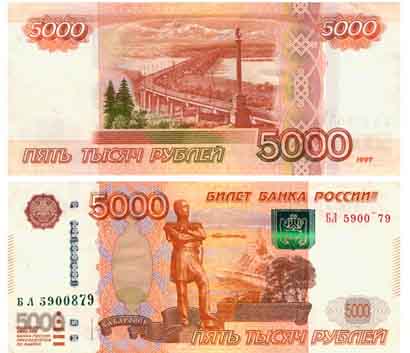Throughout its history Russia has had various version of the ruble, which is divided into 100 kopeks. The latest manifestation (RUB, replacing the RUR) was introduced in 1998 (although all notes and first issues of coins bear the year 1997). All pre-1998 currency is obsolete.
Coins are issued in 1, 5, 10, and 50 kopek and 1, 2, 5, and 10 ruble denominations. Banknotes come in 5, 10, 50, 100, 500, 1000, and 5000 ruble. The 5 ruble note is no longer issued or found in general circulation. The 10 ceased being printed in 2010 and will suffer the same fate. Both remain legel tender. Kopeks are generally useless, with most prices given to the nearest ruble. The 1 and 5 kopek coins are especially useless: even places that quote prices in non whole rubles will round to the nearest 10 kopeks. The ruble has been fairly stable in recent years (up to 2012), hovering around 30 to the US dollar and about 42 to the euro.
All banknotes have special marks (dots and lines in relief) to aid the blind in distinguishing values.
Checks : Forget about travelers' checks (only some banks, such as Sberbank, will cash even American Express), and bring enough cash to last you for a few days, as occasionally communications networks handling ATM and credit card transactions are not available (as elsewhere in the world).
Sberbank will cash American Express without comission.Russian law forbids payments not in rubles. Fortunatley, currency exchange offices (called bureaus in Saint Petersburg) are common throughout Russia. Banks and small currency exchange bureaus offer very good rates; hotels are generally expensive and thus not recommended. You need to show your passport at banks. Be sure to take your time to count how much money you got — different ways are sometimes used to trick the customer.
Small window-in-the-wall offices abound in Moscow and Saint Petersburg but are rare in other cities. They usually offer better exchange rates but don't require identification nor provide any receipts in most cases. Branches of large banks can be found in any major city, and Sberbank outlets are a must in any village down to rayonny centr. Branches of banks are more trustworthy for not-so-attractive rates, and exchange session would last longer requiring a passport and giving you all the receipts you can imagine.
Window-in-the-wall exchanges frequently attract clients by declaring rates for amounts >$1000 / >EUR1000 (but stating this in small font). Rates for smaller amounts are demonstrated only in the window itself and are typically less attractive than even at regular banks. Frequently, people don't notice that rates are different. To make the difference even less evident, rates are set exactly 1 ruble differece, like 34.18 and 35.18 per Euro. Another trick used by windows-in-the-walls is a tray that makes 1-2 banknotes stick so they become hidden from you. Always check the amounts you are given. Many exchange bureaus will also convert other currencies beyond USD and EUR, although often the rate is not as good. You can compare rates if you buy USD/EUR in your country and sell them in Russia vs direct exchanges from your local currency to rubles at; it displays exchange rates for cash in Moscow for every currency exchanged in Russia.
You will have easier time changing money if your banknotes are absolutely clean, and dollars should be the most recent updated design, as few places will accept the older versions.
Don't change money on the street. Unlike during Soviet times, there is no advantage to dealing with an unofficial vendor. There are several advanced schemes of scam for exchange on the street — better not give them a try.
ATMs , called bankomats, are common in large cities and can generally be found in smaller cities and towns. Though some may not accpet foreign cards. English language interface is available. Some may also dispense U.S. dollars. Russian ATMs will often limit withdrawals to about USD$1,000 per day. Big hotels are good places to find them. In Moscow and Saint Petersburg more and more shops, restaurants, and services take credit cards. Visa/MasterCard are more accepted than American Express; Discover, Diners Club and other cards are rarely accepted. Most upscale establishments will accept credit cards, but beyond these it is pure chance.
Museums and sightseeing places take only cash, no credit cards. Have plenty of cash on hand each day to cover entrance fees, photographic fees (museums charge a fee for cameras and video recorders), tours, souvenirs, meals and transportation.
Train Stations may accept plastic, even outside the big cities, be sure to ask as it won't always be obvious. Otherwise take plenty of cash. ATM machines at train station are populat and often out of cash, so stock up before going to the train station.
Like anywhere in the world, it's better to avoid street ATMs (or at least to be very careful), as sometimes swindlers attach spy devices to them, to get your PIN and card details; the safest option is the ATMs in hotels, banks or big shopping centers.
Ten rubles. The ticket bank is yellow green, it has number of identification of letters and numbers, recording TICKET OF BANK OF RUSSIA, and curiosity of the city of Krasnoyarsk: bridge across the river Enisey, the largest river of Russia, and the hydroelectric plant of Krasnoyask. Ticket have watermarks with the number of nominal ticket and curiosities of the city. From the 1st of October 2009 it is not manufactured any more but continues to be in circulation, and from this date being replaced by the currency of the same nominal. The same as a ticket of five rubles, ten no longer being printed.
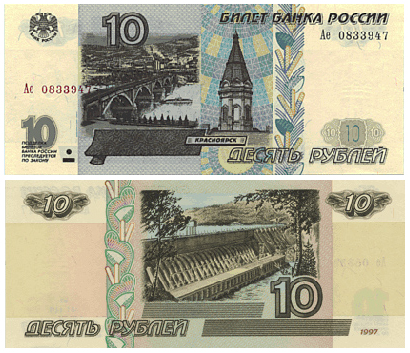
Fifty roubles. The ticket bank is of clear blue colour, has a number of identification of letters and numbers, recording TICKET OF BANK OF RUSSIA, and curiosity of the city of St. Petersburg. Ticket have watermarks with the number of nominal ticket and curiosities of the city.
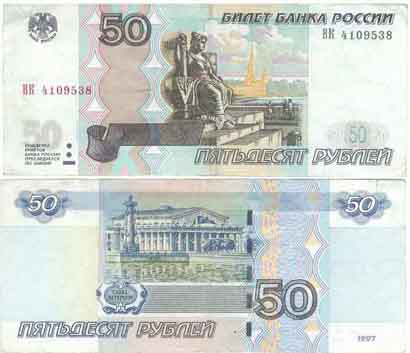
Hundred roubles. The ticket bank is yellow, has a number of identification of letters and numbers, recording TICKET OF BANK OF RUSSIA, and curiosity of the city of Moscow - precisely the Bolshoy Theatre and the statue of Apollo in the chariot drawn by four horses above the entrance. Ticket have watermarks with the number of nominal ticket and Bolshoy Theatre.

five Hundred rubles. The ticket bank is colored violated, have an id number of letters and numbers, recording TICKET OF BANK OF RUSSIA, and curiosity of the city of Arkhangelsk, the ancient city where the river Dvina from the North flows into the White Sea. Ticket have watermarks with the number of nominal ticket and curiosities of the city.
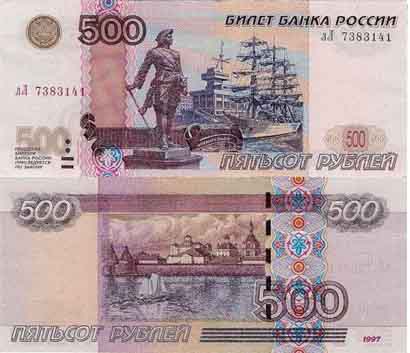
A thousand rubles. The ticket bank is in blue color green, number of identification of letters and numbers, recording TICKET OF BANK OF RUSSIA, and curiosity of the city of Yaroslavl, old city (about a millennium) but not as much as that of Novgorod the Great. Ticket have watermarks with the number of nominal ticket and curiosities of the city.
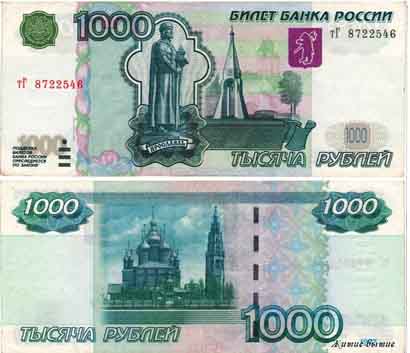
Five thousand rubles. The ticket bank is of color orange red purple, has a number of identification of letters and numbers, recording TICKET OF BANK OF RUSSIA, and curiosity of the city of Khabárovsk located in the Far East on the Amur river.
